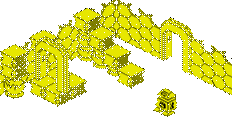Atari 400/800
Vital Statistics
Introduced
October 1979 |
|
![]()
What's it like today?
|
In 1979, Atari's new 'home computer' division introduced two machines: the 400 and the 800. They debuted at the Winter Consumer Electronics Show in Las Vegas.
Designed primarily as a computer for children, the Atari 400 had an "advanced child-proof design featuring pressure-sensitive, wipe-clean keyboard". It had a single cartridge port under the front cover. The Atari 400 booted up into "Notepad", the only built-in program. Any other programs would have to run from either cassette or cartridge, This included BASIC, or any other programming language. Initially sold with just 8K of RAM, this was soon expanded to 16K as standard. You could increase the memory by purchasing the "Atari 400 48K RAM Expansion Kit" which was sold by dealers, although this required the dealer to install it on the customer's behalf.
Lacking sufficient memory and having an inadequate keyboard, the Atari 400 was best used simply for playing games. Many games were clones of actual video arcade hits, others were original or copies of other popular (or not) computer games of the 80's. The 400 came with 4 joystick ports.
 The Atari 800 was 100% backward compatible with the 400, and had two cartridge sockets, a proper typewriter-style keyboard, more RAM (16K initially, but later expanded to 48K) and it even came with a video cassette recorder socket.
The Atari 800 was 100% backward compatible with the 400, and had two cartridge sockets, a proper typewriter-style keyboard, more RAM (16K initially, but later expanded to 48K) and it even came with a video cassette recorder socket.
It also had a composite video DIN socket built-in to allow connection to a high-resolution colour monitor.
Both the Atari 400 and 800 were designed by a team which included Jay Miner, who later went on to help design the Commodore Amiga 1000.











